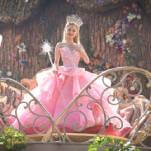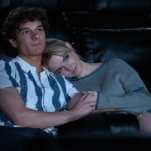Post Tenebras Lux opens with two of the most astonishing sequences in recent memory. In the first, a little girl of about 2 or 3 wanders gleefully across a muddy landscape filled with cows and large dogs, taking evident pleasure simply in being alive. As she does so, darkness gradually falls and a thunderstorm moves in; there’s no overt threat of danger, but the juxtaposition of child and nature has an elemental power that’s truly breathtaking. This slight sense of the uncanny gets multiplied a thousandfold in the following scene, which sees an animated demon composed entirely of bright red light moving silently through a dark house in the middle of the night, carrying a (non-animated) toolbox for reasons unknown. At this point, about 12 minutes in, Post Tenebras Lux (the title is a Latin phrase meaning “after darkness, light”) looks like a contender for the greatest movie ever made—especially since director Carlos Reygadas’ previous feature, 2007’s Silent Light, ranks among the best films of our young century to date.
Then the narrative kicks in—to the limited extent that the film has one, that is—and it turns out to be a real head-scratcher, largely devoid of the spooky grandeur of that initial one-two punch. The film introduces the occupants of the dark house (a family of four, including the little girl from the opening) and observes them over an indeterminate period of time, during which nothing of particular note happens. Time is fluid: At one point the movie leaps well into the future, depicting the kids as teenagers, and a scene in which the parents take part in a weirdly solemn swingers’ orgy seems to take place at some point in the past, judging from the characters’ radically different physical appearances. Dad (Adolfo Jiménez Castro) has serious anger issues—at one point he beats the family dog to death—and there are vague intimations of class warfare involving the family’s handyman (Willebaldo Torres). But for the most part the movie just meanders, veering back and forth between the magnificently evocative and the willfully obscure.
Viewers can’t accuse of Reygadas of repeating himself, that’s for sure. Silent Light was notable for its majestic widescreen compositions; Post Tenebras Lux, by extreme contrast, was shot in the nearly square Academy ratio, and all exteriors employ a strange effect in which the frame is sharp at the center but goes blurry in a circle around the edges, with multiple exposures occurring across the border area. The purpose of this device is unclear, as are various other elements—most notably, the occasional, unexplained cutaways to British kids playing rugby—that seem be autobiographical touches from Reygadas. (He went to school in England.) The film is never less than fascinating, but it appears to be so intensely personal as to be all but indecipherable to viewers not personally acquainted with the filmmaker, or at least in possession of the press kit. That’s arguably preferable to Hollywood movies that laboriously spell everything out for the dimwitted, but there’s a happy medium, and Reygadas has located it before. Here’s hoping he will again.








































